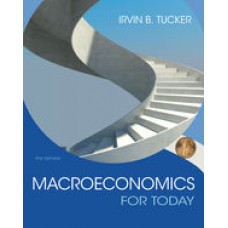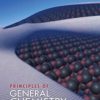Test Bank for Macroeconomics for Today, 9th Edition
$35.00 Original price was: $35.00.$26.50Current price is: $26.50.
Test Bank for Macroeconomics for Today, 9th Edition
This is completed downloadable of Test Bank for Macroeconomics for Today, 9th Edition

Product Details:
- ISBN-10 : 1305507142
- ISBN-13 : 978-1305507142
- Author: Dr. Irvin B. Tucker
Now you can truly visualize economics with the most student-friendly economics text on the market: Irvin Tucker’s MACROECONOMICS FOR TODAY, 9E. Written by a national award-winning educator, MACROECONOMICS FOR TODAY clearly presents concepts using a writing style that is engaging and clear, no matter what your current level of economic understanding. A unique textual and visual learning system, colorful graphs, and causation chains clarify concepts. The book concisely presents and reinforces core concepts, then gives opportunities to immediately assess your comprehension. You study the latest economic information on economic growth, income distribution, federal deficits, environmental issues, and other developments in economics today with an engaging, easy-to-follow format that applies principles to everyday life. Numerous printed and online study tools, including a companion website, help you further master key principles in economics today.
Table of Contents
- Part 1: Introduction to Economics
- Ch 1: Introducing the Economic Way of Thinking
- Ch 1: Introduction
- Ch 1: In This Chapter, You Will Learn to Solve These Economics Puzzles:
- 1-1:The Problem of Scarcity
- 1-2: Scarce Resources and Production
- 1-3: Economics: the Study of Scarcity and Choice
- 1-4: The Methodology of Economics
- 1-5: Hazards of the Economic Way of Thinking
- 1-6: Why Do Economists Disagree?
- 1-7: Careers in Economics
- Ch 1: Key Concept
- Ch 1: Summary
- Ch 1: Summary of Conclusion Statements
- Ch 1: Study Questions and Problems
- Ch 1: Sample Quiz
- Appendix to Chapter 1: Applying Graphs to Economics
- Ch 2: Production Possibilities, Opportunity Cost, and Economic Growth
- Ch 2: Introduction
- Ch 2: In This Chapter, You Will Learn to Solve These Economics Puzzles:
- 2-1: Three Fundamental Economic Questions
- 2-2: Opportunity Cost
- 2-3: Marginal Analysis
- 2-4: The Production Possibilities Curve
- 2-5: The Law of Increasing Opportunity Costs
- 2-6: Sources of Economic Growth
- 2-7: Present Investment and the Future Production Possibilities Curve
- Ch 2: Key Concept
- Ch 2: Summary
- Ch 2: Summary of Conclusion Statements
- Ch 2: Study Questions and Problems
- Ch 2: Sample Quiz
- Part 1: Road Map
- Part 2: Microeconomics Fundamentals
- Ch 3: Market Demand and Supply
- Ch 3: Introduction
- Ch 3: In This Chapter, You Will Learn to Solve These Economics Puzzles:
- 3-1: The Law of Demand
- 3-2: The Distinction Between Changes in Quantity Demanded and Changes in Demand
- 3-3: Nonprice Determinants of Demand
- 3-4: The Law of Supply
- 3-5: The Distinction Between Changes in Quantity Supplied and Changes in Supply
- 3-6: Nonprice Determinants of Supply
- 3-7: A Market Supply and Demand Analysis
- Ch 3: Key Concept
- Ch 3: Summary
- Ch 3: Study Questions and Problems
- Ch 3: Sample Quiz
- Appendix to Chapter 3: Consumer Surplus, Producer Surplus, and Market Efficiency
- Ch 4: Markets in Action
- Ch 4: Introduction
- Ch 4: In This Chapter, You Will Learn to Solve These Economics Puzzles:
- 4-1: Changes in Market Equilibrium
- 4-2: Can the Laws of Supply and Demand Be Repealed?
- 4-3: Market Failure
- Ch 4: Key Concept
- Ch 4: Summary
- Ch 4: Summary of Conclusion Statements
- Ch 4: Study Questions and Problems
- Ch 4: Sample Quiz
- Appendix to Chapter 4: Applying Supply and Demand Analysis to Health Care
- Part 3: Macroeconomics Fundamentals
- Ch 5: Gross Domestic Product
- Ch 5: Introduction
- Ch 5: In This Chapter, You Will Learn to Solve These Economics Puzzles:
- 5-1: Gross Domestic Product
- 5-2: Measuring GDP
- 5-3: The Expenditure Approach
- 5-4: The Income Approach
- 5-5: Gdp Shortcomings
- 5-6: Other National Income Accounts
- 5-7: Changing Nominal GDP to Real GDP
- Ch 5: Key Concept
- Ch 5: Summary
- Ch 5: Summary of Conclusion Statements
- Ch 5: Study Questions and Problems
- Ch 5: Sample Quiz
- Appendix to Chapter 5: A Four-Sector Circular Flow Model
- Ch 6: Business Cycles and Unemployment
- Ch 6: Introduction
- Ch 6: In This Chapter, You Will Learn to Solve These Economics Puzzles:
- 6-1: The Business–Cycle Roller Coaster
- 6-2: Unemployment
- 6-3: Types of Unemployment
- 6-4: The Goal of Full Employment
- 6-5: Nonmonetary and Demographic Consequences of Unemployment
- Ch 6: Key Concept
- Ch 6: Summary
- Ch 6: Summary of Conclusion Statements
- Ch 6: Study Questions and Problems
- Ch 6: Sample Quiz
- Ch 7: Inflation
- Ch 7: Introduction
- Ch 7: In This Chapter, You Will Learn to Solve These Economics Puzzles:
- 7-1: Meaning and Measurementof Inflation
- 7-2: Consequences of Inflation
- 7-3: Demand-Pull and Cost-Push Inflation
- Ch 7: Key Concept
- Ch 7: Summary
- Ch 7: Summary of Conclusion Statements
- Ch 7: Study Questions and Problems
- Ch 7: Sample Quiz
- Part 3: Road Map
- Part 4: Macroeconomics Theory and Policy
- Ch 8: The Keynesian Model
- Ch 8: Introduction
- Ch 8: In This Chapter, You Will Learn to Solve These Economics Puzzles:
- 8-1: Introducing Classical Theory and the Keynesian Revolution
- 8-2: Reasons the Consumption Function Shifts
- 8-3: Investment Expenditures
- 8-4: Why Investment Demand Is Unstable
- Ch 8: Key Concept
- Ch 8: Summary
- Ch 8: Summary of Conclusion Statements
- Ch 8: Study Questions and Problems
- Ch 8: Sample Quiz
- Ch 9: The Keynesian Model in Action
- Ch 9: Introduction
- Ch 9: In This Chapter, You Will Learn to Solve These Economics Puzzles:
- 9-1: Adding Government and Global Trade to the Keynesian Model
- 9-2: The Aggregate Expenditures Model
- 9-3: The Spending Multiplier Effect
- 9-4: Recessionary and Inflationary Gaps
- Ch 9: Key Concept
- Ch 9: Summary
- Ch 9: Summary of Conclusion Statements
- Ch 9: Study Questions and Problems
- Ch 9: Sample Quiz
- Ch 10: Aggregate Demand and Supply
- Ch 10: Introduction
- Ch 10: In This Chapter, You Will Learn to Solve These Economics Puzzles:
- 10-1: The Aggregate Demand Curve
- 10-2: Reasons for the Aggregate Demand Curve’s Shape
- 10-3: Nonprice-Level Determinants of Aggregate Demand
- 10-4: The Aggregate Supply Curve
- 10-5: Changes in AD–AS Macroeconomic Equilibrium
- 10-6: Nonprice-Level Determinants of Aggregate Supply
- 10-7: Cost-Push and Demand-Pull Inflation Revisited
- Ch 10: Key Concept
- Ch 10: Summary
- Ch 10: Summary of Conclusion Statements
- Ch 10: Study Questions and Problems
- Ch 10: Sample Quiz
- Appendix to Chapter 10: The Self-Correcting Aggregate Demand and Supply Model
- Ch 11: Fiscal Policy
- Ch 11: Introduction
- Ch 11: In This Chapter, You Will Learn to Solve These Economics Puzzles:
- 11-1: Discretionary Fiscal Policy
- 11-2: Automatic Stabilizers
- 11-3: Supply-Side Fiscal Policy
- Ch 11: Key Concept
- Ch 11: Summary
- Ch 11: Summary of Conclusion Statements
- Ch 11: Study Questions and Problems
- Ch 11: Sample Quiz
- Ch 12: The Public Sector
- Ch 12: Introduction
- Ch 12: In This Chapter, You Will Learn to Solve These Economics Puzzles:
- 12-1: Government Size and Growth
- 12-2: Financing Government Budgets
- 12-3: The Art of Taxation
- 12-4: Public Choice Theory
- Ch 12: Key Concept
- Ch 12: Summary
- Ch 12: Summary of Conclusion Statements
- Ch 12: Study Questions and Problems
- Ch 12: Sample Quiz
- Ch 13: Federal Deficits, Surpluses, and the National Debt
- Ch 13: Introduction
- Ch 13: In This Chapter, You Will Learn to Solve These Economics Puzzles:
- 13-1: The Federal Budget Balancing Act
- 13-2: Budget Surpluses and Deficits in Other Countries
- 13-3: Why Worry over the National Debt?
- Ch 13: Key Concept
- Ch 13: Summary
- Ch 13: Summary of Conclusion Statements
- Ch 13: Study Questions and Problems
- Ch 13: Sample Quiz
- Part 4: Road Map
- Part 5: Money, Banking, and Monetary Policy
- Ch 14: Money and the Federal Reserve System
- Ch 14: Introduction
- Ch 14: In This Chapter, You Will Learn to Solve These Economics Puzzles:
- 14-1: What Makes Money Money?
- 14-2: Money Supply Definitions
- 14-3: The Federal Reserve System
- 14-4: What a Federal Reserve Bank Does
- 14-5: The U.S. Banking Revolution
- Ch 14: Key Concept
- Ch 14: Summary
- Ch 14: Summary of Conclusion Statements
- Ch 14: Study Questions and Problems
- Ch 14: Sample Quiz
- Ch 15: Money Creation
- Ch 15: Introduction
- Ch 15: In This Chapter, You Will Learn to Solve These Economics Puzzles:
- 15-1: Money Creation Begins
- 15-2: Multiplier Expansion of Money by the Banking System
- 15-3: How Monetary Policy Creates Money
- 15-4: Monetary Policy Shortcomings
- Ch 15: Key Concept
- Ch 15: Summary
- Ch 15: Summary of Conclusion Statements
- Ch 15: Study Questions and Problems
- Ch 15: Sample Quiz
- Ch 16: Monetary Policy
- Ch 16: Introduction
- Ch 16: In This Chapter, You Will Learn to Solve These Economics Puzzles:
- 16-1: How Are Interest Rates Determined?
- 16-2: The Monetarist View of the Role of Money
- 16-3: A Comparison of Macroeconomic Views
- Ch 16: Key Concept
- Ch 16: Summary
- Ch 16: Summary of Conclusion Statements
- Ch 16: Study Questions and Problems
- Ch 16: Sample Quiz
- Appendix to Chapter 16: Policy Disputes Using the Self-correcting Aggregate Demand and Supply Model
- Ch 17: The Phillips Curve and Expectations Theory
- Ch 17: Introduction
- Ch 17: In This Chapter, You Will Learn to Solve These Economics Puzzles:
- 17-1: The Phillips Curve
- 17-2: The Long-Run Phillips Curve
- 17-3: The Theory of Rational Expectations
- 17-4: Applying the AD-AS Model to the Great Expectations Debate
- 17-5: Incomes Policy
- 17-6: How Different Macroeconomic Theories Attack Inflation
- Ch 17: Key Concept
- Ch 17: Summary
- Ch 17: Summary of Conclusion Statements
- Ch 17: Study Questions and Problems
- Ch 17: Sample Quiz
- Part 5: Road Map
- Part 6: The International Economy
- Ch 18: International Trade and Finance
- Ch 18: Introduction
- Ch 18: In This Chapter, You Will Learn to Solve These Economics Puzzles:
- 18-1: Why Nations Need Trade
- 18-2: Absolute and Comparative Advantage
- 18-3: Free Trade Versus Protectionism
- 18-4: Arguments for Protection
- 18-5: The Balance of Payments
- 18-6: Exchange Rates
- Ch 18: Key Concept
- Ch 18: Summary
- Ch 18: Summary of Conclusion Statements
- Ch 18: Study Questions and Problems
- Ch 18: Sample Quiz
- Ch 19: Economies in Transition
- Ch 19: Introduction
- Ch 19: In This Chapter, You Will Learn to Solve These Economics Puzzles:
- 19-1: Basic Types of Economic Systems
- 19-2: The “ISMS”
- 19-3: Economies in Transition
- Ch 19: Key Concept
- Ch 19: Summary
- Ch 19: Summary of Conclusion Statements
- Ch 19: Study Questions and Problems
- Ch 19: Sample Quiz
- Ch 20: Growth and the Less-Developed Countries
- Ch 20: Introduction
- Ch 10: In This Chapter, You Will Learn to Solve These Economics Puzzles:
- 20-1: Comparing Developed and Less-Developed Countries
- 20-2: Economic Growth and Development Around the World
- 20-3: The Helping Hand of Advanced Countries
- Ch 20: Key Concept
- Ch 20: Summary
- Ch 20: Summary of Conclusion Statements
- Ch 20: Study Questions and Problems
- Ch 20: Sample Quiz
- Part 6: Road Map
- Appendix A: Answers to Odd-Numbered Study Questions and Problems
- Appendix B: Answers to Sample Quizzes
- Appendix C: Answers to Road Map Questions
- Glossary
- Index
People Also Search:
macroeconomics for today, 9th edition
macroeconomics for today











